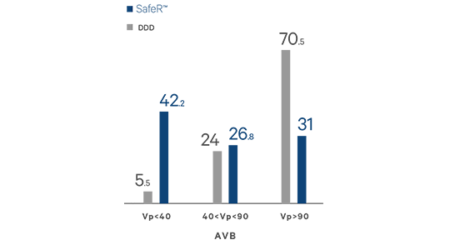Unique benefits of SafeR™
Reduces VP while managing Long PR
SafeR™ is the only AV management solution proven to reduce ventricular pacing while at the same time managing long PR intervals.
Safe & effective
Proven to be safe and effective1,7 for all pacemaker patients even for patients with permanent or complete heart block.
Responds to rest and exercise
The duration of the PR intervals is programmable ranging from 200 to 450ms. The settings can be adjusted to suit the patient’s activity both at rest and during exercise.
Improves patient management
Offers a full diagnostic data and unique categorization of AVB episodes:
- Detailed diagnosis of each AV block episode experienced by the patient
- Report on the occurrence of AV block episodes at night and during the day
- Evolution of PR duration versus heart rate

The ANSWER study1,7
The clinical benefits of SafeR™ were investigated during the ANSWER study after 3 years follow-up.1 The ANSWER study proved that SafeR is:
- Safe & effective for all brady patients1,7
- Proven to strongly reduce ventricular pacing for AV block patients as well as for SND patients1,7
- Significantly increases the number of patients with less than 40% pacing1,7
